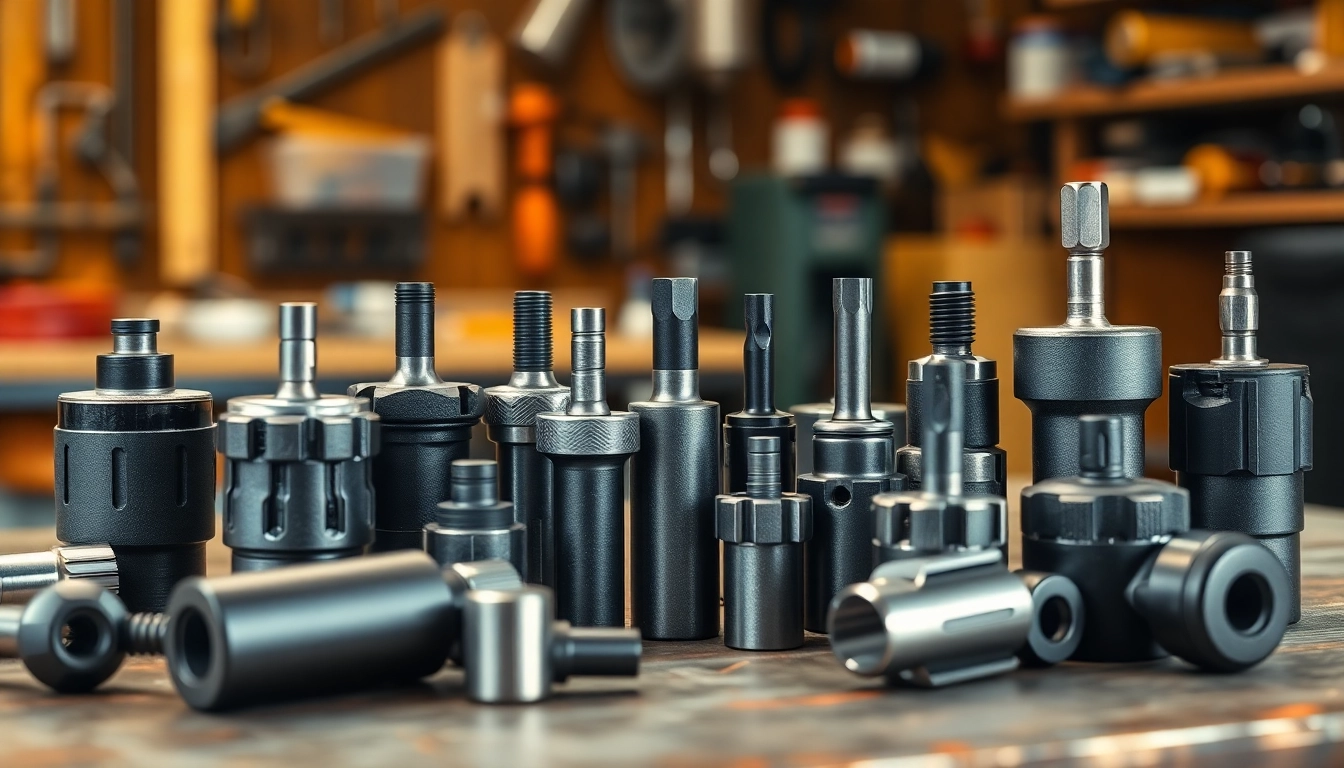Understanding Drill Chucks: Types and Features
When it comes to choosing a drill chuck, understanding its types and features is crucial. A drill chuck is a device that holds the drill bit securely while you work on various projects, be it woodworking, metalworking, or any DIY task. This component’s primary function ensures precision and stability as you drill. In this section, we will explore the different types of drill chucks, their features, and their applications.
Keyed vs. Keyless Drill Chucks
Drill chucks generally fall into two categories: keyed and keyless. Let’s delve into the features and benefits of each type.
Keyed Drill Chucks
Keyed drill chucks use a specific key to tighten or loosen the grip on the drill bit. The key fits into a slot on the chuck, allowing you to apply enough torque to secure the bit firmly. The main advantages of keyed chucks include:
- Increased Torque: Keyed chucks excel in applications requiring higher torque, making them suitable for heavy-duty tasks.
- Secure Grip: They can hold bits of various sizes securely, reducing the chances of slippage during operation.
- Durability: Keyed chucks are often made of robust materials, making them long-lasting and reliable.
Keyless Drill Chucks
Keyless drill chucks simplify the bit-changing process by allowing users to tighten or loosen the chuck by hand. This convenience offers several benefits:
- Quick Bit Changes: You can easily switch bits without needing a key, saving valuable time.
- Ease of Use: Ideal for those who frequently change bits, keyless chucks are user-friendly and require less finesse.
- Compact Size: These chucks generally have a smaller form factor, beneficial for portability and maneuverability in tight spaces.
Common Sizes and Thread Options
Drill chucks come in various sizes, with common capacities typically ranging from 1/4 inch to 1/2 inch. The size of the chuck and the thread type that connects it to the drill are crucial in determining compatibility.
Common Chuck Sizes
Typical nominal sizes include:
- 3/8 inch: Common for lighter tasks and smaller drills.
- 1/2 inch: Ideal for heavy-duty applications and larger drill bits.
Thread Options
Most drill chucks feature standard threads, such as:
- 1/2-20: Common in many power drills.
- 3/8-24: Generally found in compact hand drills.
Materials Used in Manufacturing Drill Chucks
The materials used to manufacture drill chucks impact their performance and longevity. Some common materials include:
- Steel: The most common material offers strength and durability.
- Aluminum: Lightweight and resistant to corrosion, aluminum chucks are often used for portable drills.
- Plastic Composites: While less durable, these are typically used in budget models where weight reduction is necessary.
How to Select the Perfect Drill Chuck
Selecting the right drill chuck not only enhances performance but also improves productivity. Here are key factors to consider when making a choice.
Assessing Your Drilling Needs
Before purchasing a drill chuck, identify the specific applications for which it will be used:
- Type of Material: The material you’ll be drilling into can dictate the type of chuck needed. For example, hardwood requires a chuck that can accommodate larger bits.
- Frequency of Use: If you frequently switch bits, a keyless chuck may be optimal for efficiency.
- Torque Requirements: High torque applications necessitate a keyed chuck for secure bit retention.
Factors to Consider When Buying a Drill Chuck
Several other factors can influence your decision:
- Chuck Size: Ensure the chuck size matches the drill and intended bit sizes.
- Quality of Construction: High-quality materials equate to durability.
- Brand Reputation: Brands known for precision and reliability can offer peace of mind.
Brand Comparison: Top Drill Chuck Manufacturers
Comparing various manufacturers helps to provide clarity on which brands excel in terms of performance, price, and features. Some notable manufacturers include:
- Albrecht: Known for precision and accuracy, often regarded as premium.
- Röhm: Offers a wide range of high-quality chucks catering to various industrial needs.
- Jacobs: A well-established brand providing durable options suitable for various applications.
Installation and Maintenance of Drill Chucks
Proper installation and maintenance of drill chucks are essential for optimal performance and longevity. Here’s a guide to ensure you get the best from your chuck.
Step-by-Step Installation Guide
Installing a drill chuck involves the following steps:
- Unplug the Drill: Always ensure your drill is unplugged before changing the chuck.
- Remove the Old Chuck: Use the correct tool to unscrew the existing chuck or use a chuck key if applicable.
- Align Threading: If the new chuck has a thread, ensure it aligns with the drill spindle.
- Tighten Securely: Use the appropriate tool or hand tighten if it’s a keyless model.
Maintenance Tips for Longevity
Regular maintenance ensures your drill chuck remains in optimal condition, enhancing its lifespan:
- Keep Clean: Clean with a cloth to remove debris that may warp or damage the chuck.
- Lubricate: Occasionally apply lubricant to prevent rust and ensure seamless operation.
- Inspect Regularly: Check for wear and tear and replace any damaged components promptly.
Common Issues and Troubleshooting
If you encounter issues with your drill chuck, some common problems and solutions include:
- Slippage: Ensure the chuck is tightened adequately. For keyed chucks, use the key to apply more torque.
- Bit Binding: Use the correct bit size and type for the material being drilled.
- Difficulty Changing Bits: For keyless chucks, ensure that the grip mechanism is functioning correctly; lubricate if necessary.
Advanced Applications of Drill Chucks
Beyond basic drilling tasks, drill chucks can be utilized in various advanced applications across different industries, enhancing workflow and output.
Using Drill Chucks in Specific Industries
Drill chucks serve a variety of industries, including:
- Manufacturing: Used extensively for machining processes.
- Construction: Power drills fitted with chucks are essential for assembly and installation tasks.
- Woodworking: Precision is critical in woodworking, where accuracy in drilling directly impacts quality.
Innovative Techniques for Enhanced Performance
Here are some innovative techniques for using drill chucks to their fullest potential:
- Specialized Bits: Using bits designed for specific tasks improves performance and reduces strain on the chuck.
- Drilling Guides: Employing drilling guides can ensure uniform depth and straight drilling, enhancing precision.
- Routine Training: Regular training for operators to understand the nuances of chuck management can optimize their use.
Future Trends in Drill Chuck Technology
As technology evolves, drill chucks are adapting to meet new demands:
- Smart Chucks: Future drill chucks may feature sensors to monitor torque, wear, and provide diagnostic information.
- Eco-Friendly Materials: The industry is likely to shift towards using sustainable materials in chuck manufacturing.
- Integration with Power Tools: Smarter chucks might directly communicate with power tools to optimize performance based on the task.
Frequently Asked Questions About Drill Chucks
To assist you further, here are some frequently asked questions regarding drill chucks:
How to Choose the Right Size Drill Chuck?
Choosing the right drill chuck size involves considering the type and size of bits you will be using. Opt for a chuck that can accommodate the largest diameter bit you anticipate using while being compatible with your drill’s design.
Can I Use Different Types of Drill Chucks on My Tool?
While many drills accept various types of chucks, it’s crucial to check the compatibility with your drill’s spindle size and threading. Ensure that the chuck fits securely on your drill to guarantee safety and efficiency.
What Are the Best Practices for Drill Chuck Usage?
Practicing safe and efficient usage involves:
- Using appropriate bit sizes.
- Regularly checking and maintaining the chuck.
- Tightening bits securely in the chuck to prevent slippage during operation.



